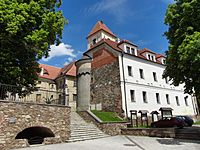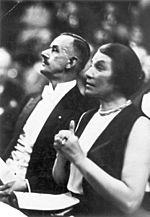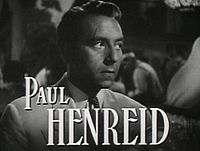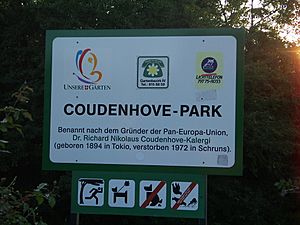Richard von Coudenhove-Kalergi facts for kids
Quick facts for kids
Richard von Coudenhove-Kalergi
|
|
|---|---|
| Count of Coudenhove-Kalergi | |
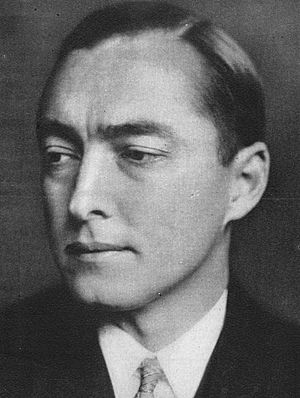 |
|
| Born | Aoyama Eijiro 16 November 1894 Tokyo, Japan |
| Died | 27 July 1972 (aged 77) Schruns, Austria |
| Noble family | Coudenhove-Kalergi |
| Father | Heinrich von Coudenhove-Kalergi |
| Mother | Mitsuko Aoyama |
| Occupation | Politician |
Richard Nikolaus Eijiro, Count of Coudenhove-Kalergi (November 16, 1894 – July 27, 1972) was an important politician and thinker. He was born in Japan but was also Austrian. He is known as a pioneer of European unity. This means he was one of the first people to strongly suggest that European countries should work together closely. He was the first president of the Paneuropean Union, a group he led for 49 years.
His father, Heinrich von Coudenhove-Kalergi, was an Austro-Hungarian diplomat. A diplomat is someone who represents their country in other nations. His mother, Mitsuko Aoyama, came from a wealthy Japanese family. Richard's childhood name in Japan was Aoyama Eijiro. He was an Austrian-Hungarian citizen, then became Czechoslovakian in 1919, and later French in 1939.
In 1923, he published his first book, Pan-Europa. This book included a form for people to join his movement. The first meeting of the Pan-Europa movement was held in 1926 in Vienna, Austria. Famous people like Albert Einstein and Sigmund Freud attended these meetings.
Richard Coudenhove-Kalergi received the first Charlemagne Prize in 1950. This award honors people who have worked for European unity. He also suggested that Beethoven's "Ode to Joy" should be the music for the European Anthem. He also proposed a special "Europe Day" and even European postage stamps.
Contents
His Family History
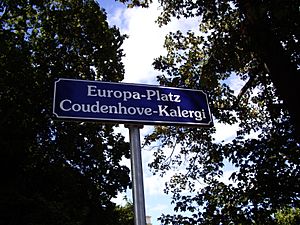
Richard Coudenhove-Kalergi was the second son of Heinrich von Coudenhove-Kalergi. His father was an Austro-Hungarian count and diplomat. His mother was Mitsuko Aoyama. Richard's father spoke many languages and traveled a lot.
His parents met in Japan when his mother helped his father after he fell off a horse. Their families came from many different places. The Coudenhoves were a rich family from Flanders, which is now part of Belgium. They moved to Austria during the French Revolution. The Kallergis family was a wealthy Greek family from Crete. Their family history also included people from Poland, Norway, and France.
When Richard was a child, his mother read him Japanese fairy tales like Momotarō.
Growing Up and Learning
Richard spent his teenage years at his family's estates in Ronsperg, a place now called Poběžovice in the Czech Republic. His father taught him and his brother many things. He taught them Russian and Hungarian. He also made them strong by taking them on long walks in all kinds of weather. They slept on straw mattresses and took cold showers. He also taught them how to shoot and fence.
Richard studied at the Augustiner-Gymnasium in Brixen. Then he went to the Theresianische Akademie in Vienna from 1908 to 1913. He earned a special degree called a doctorate in philosophy in 1917 from the University of Vienna. His main study was about how to be fair and objective in morals.
In 1915, while he was a student, Richard married Ida Roland. She was a famous actress from Vienna. She was also older than him. His mother, Mitsuko, did not like this marriage at first. She thought an actress was not a good match for her son. But she changed her mind when Richard became famous for his ideas about a united Europe.
His Ideas for Europe
Richard Coudenhove-Kalergi believed in a special kind of society. He thought that leaders should be like "gentlemen." These leaders would be honest, fair, and polite. They would also use logical thinking to solve problems. He wanted to replace the idea of nations based on race with a Europe united by shared culture. He admired great Europeans like Immanuel Kant and Victor Hugo.
Working for a United Europe
Coudenhove-Kalergi is known as the founder of the first big movement for a united Europe. He was inspired by many thinkers. In 1922, he helped start the Pan-European Union (PEU). He believed this was the best way to protect Europe. In 1923, he published his book Pan-Europa. This book encouraged people to join his movement.
In April 1924, he started a magazine called Paneuropa. He was the editor and main writer. In 1926, the first meeting of the Pan-European Union was held in Vienna. About 2,000 people attended. They chose Coudenhove-Kalergi as their president. He held this job until he died in 1972.
His original idea was for the world to have only five big groups of countries. One would be a United States of Europe. He thought that Europe, which had been badly damaged by war, needed to unite. He believed that English should be a common language for everyone in addition to their own language.
Coudenhove-Kalergi tried to get important European politicians to support his idea. He convinced some, like Aristide Briand, a French statesman. Briand spoke about a European Union at the League of Nations in 1929.
In 1929, Coudenhove-Kalergi suggested Beethoven's "Ode to Joy" as the music for the Anthem of Europe. He suggested it again in 1955 for the European Union. He also proposed a "Europe Day" in May.
However, his ideas were strongly disliked by Adolf Hitler and the Nazis. They saw his vision of a united Europe as a threat. The Nazis also thought the Pan-European Union was controlled by Freemasonry, a secret society.
After Austria was taken over by Nazi Germany in 1938, Coudenhove-Kalergi had to flee. He went to Czechoslovakia, then France, and finally to the United States in 1940. During World War II, he kept calling for Europe to unite. His experiences during the war even inspired the character Victor Laszlo in the famous movie Casablanca.
In 1944, he published another book called Crusade for Paneurope. His call for European unity gained some support from leaders like Winston Churchill and Franklin Delano Roosevelt. From 1942 to 1945, he taught history at New York University.
In 1943, the Nazis took away his doctorate degree from the University of Vienna. They falsely claimed he was "Jewish" and unworthy of the degree. He was not Jewish, and his family was not Jewish. His degree was given back to him in 1955.
After World War II ended, hopes for a united Europe grew again. In 1945, Harry S. Truman, who would become the US President, read an article by Coudenhove-Kalergi about European unity. Truman was impressed, and it influenced US policy. Winston Churchill also praised Coudenhove-Kalergi's work in a speech in 1946.
In 1947, Coudenhove-Kalergi helped create the European Parliamentary Union (EPU). He believed that a strong market with stable money would help Europe rebuild. In 1950, he received the first Charlemagne Prize for his work for European peace.
In the 1960s, Coudenhove-Kalergi encouraged Austria to work for peace. He wanted Austria to be "actively neutral" to help prevent the Cold War from getting worse. He kept pushing for European unity, suggesting a "European customs union" that would lead to a common currency.
His Ideas on People and Beliefs
In his 1925 book Practical Idealism, Coudenhove-Kalergi imagined a future where different groups of people would mix. He thought this would create a new kind of "European" person.
In 1926, he said that his Pan-European movement supported Jewish people. He believed that a united Europe would help end hatred and economic problems. In 1933, he worked with other writers to publish a pamphlet against anti-Jewish ideas, in response to the rise of Nazism.
Trips to Japan
Returning to Japan
Coudenhove-Kalergi's idea of Pan-Europe influenced a young Japanese diplomat named Morinosuke Kajima in 1922. Kajima became his friend and translated Pan-Europa into Japanese. Kajima later became a member of parliament in Japan. He respected Coudenhove-Kalergi throughout his life.
Another Japanese journalist, Yoshinori Maeda, was also influenced by the Pan-European idea. He became a pioneer of the Asia-Pacific Broadcasting Union.
In 1953, Ichirō Hatoyama started the Yuai Youth Association in Japan. This group was based on Coudenhove-Kalergi's idea of "fraternity" or brotherhood.
In 1967, Coudenhove-Kalergi received the Kajima Peace Award. He was invited to Japan by Morinosuke Kajima, Yoshinori Maeda, and Kaoru Hatoyama. He stayed in Japan for two weeks with his second wife, Alexandra, and his niece, Barbara. He met with Emperor Hirohito and other members of the Japanese royal family. This was his first visit back to Japan since he was a child, 71 years earlier. He gave many talks and met with various leaders. He also met with Dr. Daisaku Ikeda, the president of Soka Gakkai, a Buddhist organization.
Soka Gakkai Invitation
Coudenhove-Kalergi visited Japan again in October 1970, invited by the Soka Gakkai. During this trip, he had long discussions with Daisaku Ikeda. He also visited the Soka University campus, which was being built at the time.
Years later, in 1990, Ikeda suggested that Beethoven's "Ode to Joy" should be played regularly at Soka Gakkai meetings.
His Passing
Richard Coudenhove-Kalergi passed away from a stroke in 1972. He was the head of the Pan-European Union until his death. Otto von Habsburg took over the presidency after him.
Coudenhove-Kalergi is buried in Gruben near Gstaad, Switzerland. His grave is in a special Japanese rock garden in the Swiss Alps. On his grave, it says in French: "Pioneer of the United States of Europe."
He was married three times: to Ida Roland, Alexandra Gräfin von Tiele-Winckler, and Melanie Benatzky-Hoffmann. He had step-children from these marriages.
Awards and Honors
- 1950: Charlemagne Prize
- 1954: Officer of the Legion of Honour (France)
- 1962: Grand Decoration of Honour in Silver with Star of the Republic of Austria
- 1965: Sonning Prize
- 1967: Order of the Sacred Treasure, 1st class (Japan)
- 1967: Kajima Peace Award
- 1972: Konrad Adenauer Prize
- 1972: Knight Commander's Cross of the Federal Republic of Germany
- Honorary degree from Nihon University
- Honorary citizen of the University of Frankfurt a. M.
- Nominated for the Nobel Peace Prize many times
See also
 In Spanish: Richard Coudenhove-Kalergi para niños
In Spanish: Richard Coudenhove-Kalergi para niños
- Federal Europe
- Founding fathers of the European Union


